The uniforms of the Hessian army were similar to those
of the Prussian army prior to 1867 (dark blue tunic
with pointed cuffs and a tall Pickelhaube). From 1867
they wore Prussian uniforms with Hessian insignia, white
metal buttons and a
notably different Pickelhaube design.
-
The Hessian Pickelhaube had a
hexagonal fluted spike, cruciform spike base and
rounded chinscales. The Lion of Hesse between laurel
and oak leaves was the front plate with a
Hessian cockade on the left side. The Hessian
Pickelhaube cockade was white with two stripes of
red.
-
Hessian Colours (white/red)
were also used on insignia such as cockades on field
caps, trumpet cords, marksmanship lanyards,
one-year-volunteer shoulder straps, officers' belts
and on other uniform items when the Prussian army
had black and white.
-
The Hessian Lion also
replaced the Prussian Eagle or Crown on NCO collar
buttons and other insignia while the other ranks
belt buckle bore the Grand Ducal crown.
115th Life-Guard Infantry
Regiment (1st Grand Ducal Hessian)
The Leibgarde-Infanterie-Regt. (1.
Großherzoglich Hessisches) Nr.115 was originally
formed on 1st March 1621 as the Kompanie Dreßler.and
therefore had the honour of being the oldest regiment in
the German army. In 1630 they became the Fürstliche
Leib-Kompanie.
The unit fought in almost every European war of the
17th and 18th Centuries- the Thirty Years War 1616-48,
the Franco-Dutch War 1677-78, the War of the League of
Augsburg 1689-96, the War of Spanish Succession 1702-13,
the War of Polish Succession 1734-35, the War of
Austrian Succession 1747-49, the Seven Years War
1756-63, the American War of Independence 1776-83 and
the French Revolutionary Wars 1792-99.
Hesse-Darmstadt allied with France in the
Confederation of the Rhine and the regiment fought
against Prussia in 1806-07, against Austria in 1809,
against Britain in the Peninsular Campaign 1809-12,
against Russia in the Invasion of Russia in 1812 and
against the Sixth Coalition at the Battle of Leipzig in
1813. After the Battle of Leipzig they fought against
the French during the Allied Invasion of France in
1814-15.
In 1848-49 the regiment was deployed to fight
revolutionaries in Baden, while at the same time the IV
Btn fought against Denmark in the First Schleswig War.
In the Austro-Prussian War of 1866, the regiment fought
the Prussians at Frohnhofen and Gerchsheim. In the
Franco-Prussian War of 1870-71 the regiment fought at
the Battles of Mars-la-Tour and Gravelotte-St.Privat.
In 1914 the regiment was garrisoned at Darmstadt as
part of the 25th Hessian Division of the XVIII Army
Corps. During the First World War they served with the
rest of the Hessian Division on the Western Front,
seeing action at the Battles of the Marne, Verdun and
the Somme.
|
Uniform
Distinctions |
| Helmet Plate: |
From 1897 a white metal
Hessian Lion with laurel and oak leaves on either side.
A scroll above the lion bore the date of the regiment's
formation, 1621 and on the lion's chest was the Star of
the Order of Ludwig with
the motto "GOTT EHRE VATERLAND", or God, Honour (and)
Fatherland. Officers had an enamelled centre to the star
and a yellow metal ring around it. Prior to 1897 the
same helmet plate had been worn in yellow metal. |
| State
Cockade: |
Hessian (white/red/white)
with a double red stripe on the Pickelhaube cockade |
| Parade
Plume: |
Black |
| Capband and
piping: |
Red |
| Tunic
Buttons: |
White metal |
| Shoulder
Straps: |
Red with a white
crowned L monogram for Grand Duke Ludwig VI of Hessen
was worn until 1909, then EL for Grand Duke Ernst Ludwig. |
| Collar: |
Red piped along the upper
edge in dark blue with white single Litzen |
|
Cuffs: |
Brandenburg style in red
with white Litzen |
|
Other Distinctions: |
The
company number on the shoulder strap button for the 1st
Life-Company (Großherzogs Leibkompanie) was replaced by the letter L. |
116th Infantry Regiment
"Emperor Wilhelm" (2nd Grand Ducal Hessian)
The Infanterie-Regt. Kaiser
Wilhelm (2. Großherzoglich Hessisches) Nr.116 was
formed on 17th June 1813 as the Garde-Füsilier
Regiment being named the 2. Garde Regiment in
1820. They originally fought for Napoleon in the War of
Liberation including the Battle of Leipzig in 1813, then
against the French during the Allied Invasion of France
in 1813-14.
In the Austro-Prussian War of 1866, the regiment
fought the Prussians at Frohnhofen and Gerchsheim. In
the Franco-Prussian War of 1870-71 the regiment fought
alongside the Prussians at the Battles of Mars la Tour
and Gravelotte-St.Privat and the Siege of Metz.
In 1914 the regiment was garrisoned at Gießen as part
of the 25th Hessian Division of the XVIII Army Corps.
During the First World War they served with the rest of
the Hessian Division on the Western Front.
|
Uniform
Distinctions |
| Helmet Plate: |
Yellow metal Hessian
Lion with laurel and oak leaves on either side |
| State
Cockade: |
Hessian (white/red/white)
with a double red stripe on the Pickelhaube cockade |
| Parade
Plume: |
Black |
| Capband and
piping: |
Red |
| Tunic
Buttons: |
White metal |
| Shoulder
Straps: |
White with a red
crowned W II monogram for Kaiser Wilhelm II |
| Collar: |
Red piped along the upper
edge in dark blue |
| Cuffs: |
Brandenburg style in red
with vertical panel in white |
117th Life Infantry Regiment
"Grand Duchess" (3rd Grand Ducal Hessian)
The Infanterie-Leib Regt.
Großherzogin (3. Großherzoglich Hessisches) Nr.117
was originally formed on 10th June 1697 as the Kreis-Regiment.
They saw action in the war of Spanish Succession, the
Seven Years War (including the Battle of Rossbach),
the American War of Independence 1776-83
and the French Revolutionary Wars 1792-99.
In 1806 they were awarded the tile Leib-Regiment
and formed part of Hesse-Darmstadt's contingent in
the Confederation of the Rhine. Allied with France, the
regiment fought against Prussia in 1806-07, against
Austria in 1809, against Britain in the Peninsular
Campaign 1809-12, against Russia in the Invasion of
Russia in 1812 and against the Sixth Coalition at the
Battle of Leipzig in 1813. After the Battle of Leipzig
they fought against the French during the Allied
Invasion of France in 1814-15.
In the Austro-Prussian War they fought the Prussians
at the Battle of Frohnhofen. In the Franco-Prussian War
they fought the French at the Battle of
Gravelotte-St.Privat.
The Füsilier Battalion of the 117th Regiment was
formed on 1 January 1872 with personnel from the other
Grand Ducal Hessian Infantry Regiments and the former
Großherzoglich Hessisches Pionierkompanie (which
became the 117th Regiment's 9th Company). Consequently
from this date onwards 9. Kompanie of the 117th
wore the Pioneers' anchor, axe and pick device on the
helmet plate.
In 1897 Grand Duchess Victoria Melitta, wife of Grand
Duke Ernst Ludwig of Hessen was given the title of
Colonel in Chief. This title was withdrawn in 1902, the
year after the couple's divorce. Instead from that year,
the regiment was awarded the title Großherzogin
in memory of Grand Duchess Alice of Hessen (1843-78),
daughter of Queen Victoria of Great Britain, husband of
Grand Duke Ludwig IV of Hessen and mother of the
reigning Grand Duke Ernst Ludwig.
In 1914 the regiment was garrisoned at Mainz as part
of the 25th Hessian Division of the XVIII Army Corps.
During the First World War they served with the rest of
the Hessian Division on the Western Front, seeing action
at the Battles of the Marne and Verdun.
|
Uniform
Distinctions |
| Helmet Plate: |
Yellow metal Hessian
Lion with laurel and oak leaves on either side. From
1897 a scroll was added across the leaves reading 1697
on the right side and 1897 on the left. The 9th
Company had a small white metal anchor and crossed axe
and pick badge on the front of the lion. |
| State
Cockade: |
Hessian (white/red/white)
with a double red stripe on the Pickelhaube cockade |
| Parade
Plume: |
Black |
| Capband and
piping: |
Red |
| Tunic
Buttons: |
White metal |
| Shoulder
Straps: |
Prior to 1897, blue
with a red number 117. From 1897, blue with a red
crowned VM for Grand Duchess Victoria Melitta. From
1902, blue with a red crowned A monogram for Grand
Duchess Alice. |
| Collar: |
Red piped along the upper
edge in dark blue |
| Cuffs: |
Brandenburg style in red
with vertical panel in blue |
118th Infantry Regiment
"Prince Carl" (4th Grand Ducal Hessian)
The Infanterie-Regt. Prinz Carl
(4. Großherzoglich Hessisches) Nr.118 was formed on
23rd January 1791 as the Regiment Erbprinz and
first saw action against France during the Revolutionary
War. Along with the rest of the Hessian Contingent of
the Confederation of the Rhine they fought as France's
allies up until 1813 when they invaded France with the
Sixth Coalition.
In 1836 they took the title "Prinz Carl" after their
new colonel in chief, Prince Carl of Hessen (1809-77),
father of the later Grand Duke Ludwig IV, and retained
the title in memory after his death. They were deployed
for the Schleswig-Holstein War against Denmark in 1848
but saw no action. Later that year they also served
against the Revolutionaries in Baden 1848. During the
Austro-Prussian War they clashed with the Prussian army
at the Battles of Frohnhofen and Gerchsheim. They also
served alongside other Hessian regiments in the
Franco-Prussian War.
In 1914 the regiment was garrisoned at Worms as part
of the 25th Hessian Division of the XVIII Army Corps.
During the First World War they served with the rest of
the Hessian Division on the Western Front, seeing action
at the Battles of the Marne, Verdun and Vimy Ridge.
|
Uniform
Distinctions |
|
Helmet Plate: |
Yellow metal Hessian
Lion with laurel and oak leaves on either side |
|
State
Cockade: |
Hessian (white/red/white)
with a double red stripe on the Pickelhaube cockade |
|
Parade
Plume: |
None |
|
Capband and
piping: |
Red |
|
Tunic
Buttons: |
White metal |
|
Shoulder
Straps: |
Yellow with a red
number 118 |
|
Collar: |
Red piped along the upper
edge in dark blue |
|
Cuffs: |
Brandenburg style in red
with vertical panel in yellow |
168th Infantry Regiment (5th
Grand Ducal Hessian)
The 5. Großherzoglich-Hessisches
Infanterie-Regt. Nr.168 was formed on 31st March
1897. In 1914 the regiment's headquarters
and II Btn were garrisoned at Offenbach-am-Main, with
the I Btn at Butzbach and the III Btn at Friedberg as
part of the 25th Hessian Division of the XVIII Army
Corps. During the First World War they served with the
rest of the Hessian Division on the Western Front,
seeing action at the Battles of the Marne, the Somme and
Cambrai.
|
Uniform
Distinctions |
|
Helmet Plate: |
Yellow metal Hessian
Lion with laurel and oak leaves on either side |
|
State
Cockade: |
Hessian (white/red/white)
with a double red stripe on the Pickelhaube cockade |
|
Parade
Plume: |
None |
|
Capband and
piping: |
Red |
|
Tunic
Buttons: |
White metal |
|
Shoulder
Straps: |
Red with a yellow
number 168 |
|
Collar: |
Red piped along the upper
edge in dark blue |
|
Cuffs: |
Brandenburg style in red
with vertical panel in red |
Websites and Online Sources
Kaiser's
Bunker
Pickelhaubes Forum
(see
Hessian Pickelhaubes Article and
117th Life Guard Infantry Pickelhaubes Article)
Genealogy.de Der Alten Armee
|
|
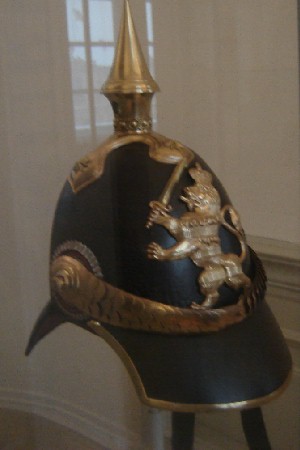
Pre-1867 Hessian Pickelhaube
Note the taller shape, typical of the period, and the lack
of laurel and oak leaves around the Lion emblem.
Photo by C Dale
at the
Military Museum, Rastatt
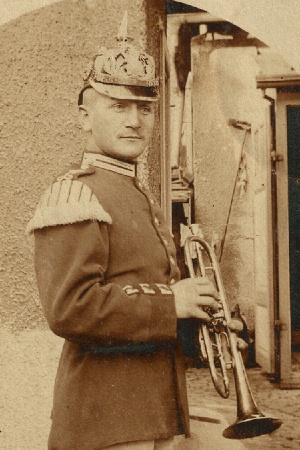
Musician from the
115th Life-Guard Infantry
Note the regiment's collar and cuff Litzen and the Musicians
Swallows Nests on the shoulder.
Photo ©
Joe Robinson
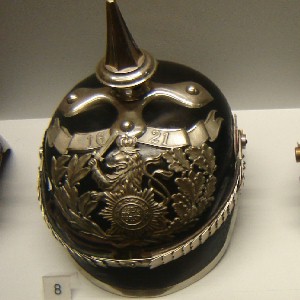
Other Ranks Pickelhaube for the
115th Life-Guard Infantry
Note the fluted spike, cruciform spike base and 1621 scroll above the lion
with a Star of the Order of Ludwig on its chest
Photo by C Dale
at the
Bavarian Army Museum, Ingolstadt
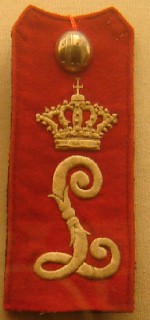 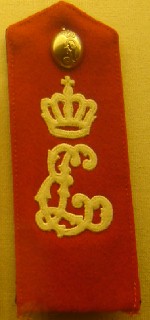
Shoulder Straps of the
115th Life-Guard Infantry
The strap on the left was worn until
1909, the one on the right was worn from then onwards.
Photo by C Dale
at the
Military Museum, Rastatt
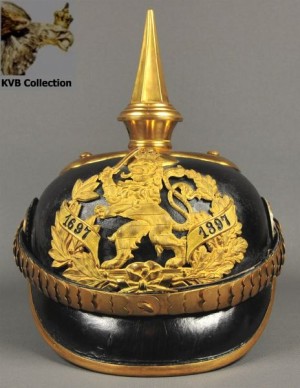
Other Ranks Pickelhaube for the
115th Life-Infantry
Note the fluted spike, cruciform spike base and 1697-1897 scrolls
on either side of the lion.
Photo © KVB Collection,
originally shown on the
Pickelhaubes Forum
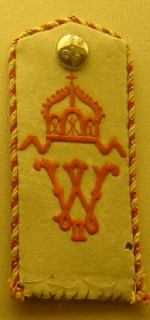 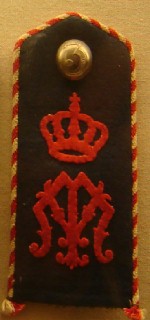
One-Year Volunteer Shoulder
Straps
On the left from the 116th Infantry and on the right from
the
117th Infantry 1897-1902.
Photo by C Dale
at the
Military Museum, Rastatt
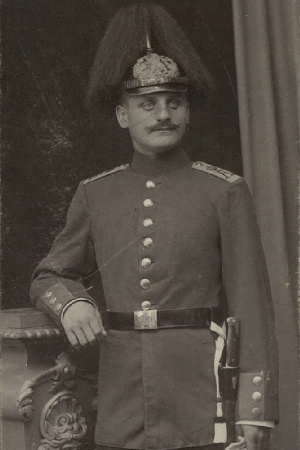
Private of the 117th Life
Infantry
Note the Crowned A monogram worn from 1902.
Photo ©
Joe Robinson
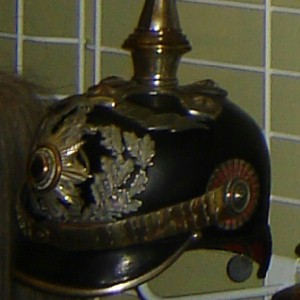
Officers Pickelhaube for the
115th Life-Guard Infantry
Note the enamelled centre to the star and a yellow metal
ring around it
Photo by C Dale at the
Army Museum, Brussels
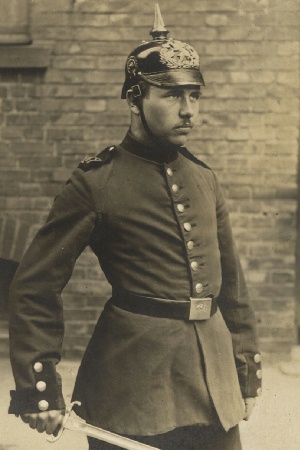
Private of the 168th Grand Ducal
Hessian Infantry
Photo ©
Joe Robinson
|